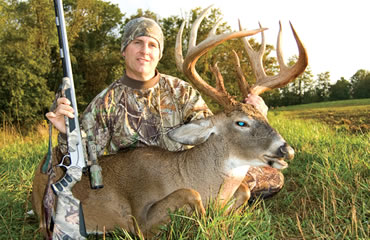Field photos, also known as grip-and-grins, are photos of hunters posing with their freshly killed animals, usually taken by a friend or relative of the hunter. As Art Director of Rack Magazine, each year, I receive hundreds of field photos. Sadly and all-too-often, the images are unusable, even of world-class bucks.
You’d be shocked how many stories of 200-inch bucks — even WORLD RECORDS — are submitted with only one or two out-of-focus, low-resolution, quickly snapped smartphone photos.
Rack Magazine prefers using field photos to create attractive magazine layouts and covers, but poorly made images sometimes make it impossible, therefore, we have to request the hunter make photos with the mount instead.
Rack editor Mike Handley and I are constantly frustrated. We cringe at grainy photos of cover-quality bucks taken with the deer lying in truck beds, hanging from gambrels, in dark garages — and every editor’s favorite — on the processer’s bloody cement floor.
We realize hunters aren’t professional photographers, but with a little knowledge and extra effort, their photos could be MUCH better. We are here to help!
Whether your photo is of a world record giant, your personal best 8-pointer or a child’s first spike, Mike and I would love to help you better preserve the memory, so we’ve decided to share a few pro tips ALL hunters can use to take amazing photographs.
Pro Photo Tips: Part One
1) Before you start, make sure your camera or smartphone is set to its highest resolution. A digital file can always be reduced, but you cannot enlarge it if taken from a low-resolution setting.
2) Lighting is your next priority. Nothing beats early morning sunlight, but afternoons aren’t bad. At midday, the sun is often severe, creating hotspots and harsh shadows. Try for morning if you can.
3) If the deer is taken late in the day, you can still take great photos at night. Use the headlights of a vehicle or two pointed at the subject. Spread a coat on the ground for the photographer to lie on and stay clean. The photographer must stay low to prevent casting his or her own shadow. Use a flash.
4) An old pro trick is to let the buck set up overnight if it’s cold enough. After field dressing the deer, roll it on its brisket, tuck its legs, then prop it up against a wall, using rope to position the buck in an attractive pose. When the light is perfect the next morning, bring the stiffened buck into the sunlight to take pictures.
5) One of my favorite shots is of a hunter and buck illuminated from the front with headlights, with a gorgeous sunset in the background. This creates an incredibly dramatic photograph! Without headlights and a good flash, this shot is not possible.
6) Avoid the shade. Drag your trophy out of the shadows and into the sunlight, and make sure it doesn’t have shadows cast across it by tree limbs or the photographer.
7) Allow your subjects to be illuminated by the sun. If sunlight causes your hunter to squint, turn the animal slightly and reposition the hunter. The lighting will still be desirable, and your subject won’t go blind.
8) Stay low — BELOW THE DEER’S NOSE. Photos taken by a standing photographer diminish antler size. A low vantage point brings the hunter’s head more level with the buck’s antlers, and the angle is much more desirable.
9) Get as close to the subjects as possible, allowing the image to fill the window in your camera’s viewfinder. Be sure everything is in focus and that the hunter’s cap and the deer’s tines won’t be cut off in the frame.
10) Experiment by standing at different angles, and find the one that shows most or all the rack’s points.
11) Be conscious of what’s behind the antlers. You don’t want the rack to get lost in a tangle of limbs.
12) Don’t forget to take vertical shots, too. Tilt the camera sideways and visual the scene as a magazine page.
13) Shoot several pictures with and without a flash.
14) Take LOTS of photos. Many pros have a philosophy that you cannot take too many pictures. You might take 50 shots and only one turn will out phenomenal.
15) SMILE! No one just stole the family dog; you just shot one of the best trophies of your career.
Take Great Field Photos: Part Two: More hunting industry photography tips, including a multi-use tip used by Buckmasters cameramen, editors and staff.
Read Recent Tip of the Week:• Avoid Cold Day Bowhunter’s Surprise: A couple of tips to help you avoid cold day bowhunter’s surprise.




.png)